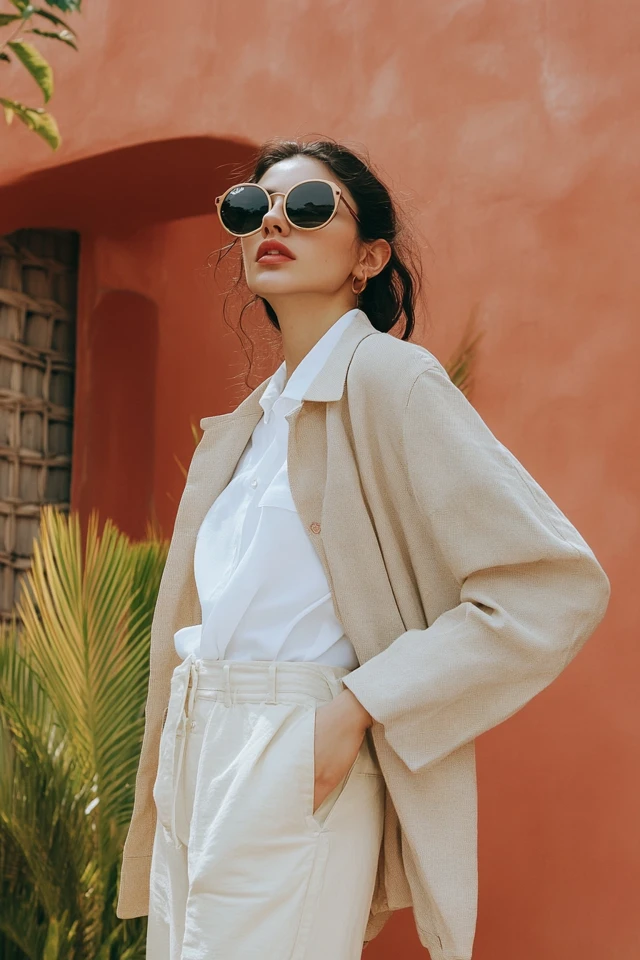Building a capsule wardrobe that transitions seamlessly through every season requires more than just choosing versatile pieces—it demands careful consideration of fabrics. The right fabrics can make your wardrobe adaptable to changing weather conditions, ensuring comfort, durability, and style year-round. Whether you’re braving the summer heat, layering up for winter, or navigating the unpredictable days of spring and fall, your choice of materials can make or break your all-weather capsule wardrobe.
I discovered the importance of fabric selection the hard way. Early in my capsule wardrobe journey, I focused solely on aesthetics, ignoring the practical side of fabrics. A chic cotton blouse turned into a sweaty mess in the summer, and my favorite wool sweater felt scratchy against my skin. Eventually, I learned to prioritize high-quality materials tailored to my climate and lifestyle. The result? A wardrobe that works beautifully in all conditions.
About the Author and My Trend Boutique
In this guide, I’ll explore the best fabrics for an all-weather capsule wardrobe, sharing tips on how to choose materials that balance breathability, warmth, durability, and style. By the end, you’ll have a clear roadmap for selecting fabrics that ensure your wardrobe performs in every season.
Foundational Concepts: Why Fabric Choice Matters
The Role of Fabrics in a Capsule Wardrobe
A capsule wardrobe is all about versatility, and fabrics are the foundation of that versatility. The materials you choose determine how well your clothing adapts to different temperatures, humidity levels, and activities.
- Breathability: Fabrics like cotton and linen keep you cool in hot weather.
- Insulation: Wool and cashmere provide warmth during colder months.
- Moisture-Wicking: Technical fabrics or merino wool help regulate body temperature.
- Durability: High-quality materials last longer, making them ideal for a capsule wardrobe.
For me, discovering merino wool was a game-changer. It’s lightweight yet warm, making it perfect for layering in winter or wearing solo in milder weather. Understanding fabrics allowed me to streamline my wardrobe and ensure every piece worked hard for me year-round.
Why Quality Over Quantity Matters
In a capsule wardrobe, where every piece earns its place, quality fabrics are essential. High-quality materials not only look and feel better but also stand up to frequent wear and washing. Investing in fabrics like organic cotton or cashmere ensures your wardrobe stays polished and functional through every season.
Picture Gallery








Best Fabrics for an All-Weather Capsule Wardrobe
Natural Fibers: Timeless and Breathable
1. Cotton
Cotton is a staple for a reason—it’s breathable, durable, and versatile. Perfect for layering or wearing alone, it works well across all seasons.
- Best For: T-shirts, button-up shirts, lightweight sweaters, and casual dresses.
- Weather Adaptability: In summer, cotton keeps you cool, while in winter, it acts as a breathable base layer.
- Pro Tip: Opt for organic or Pima cotton for added softness and durability.
My go-to white T-shirt is made from 100% organic cotton. It’s soft, breathable, and pairs effortlessly with everything from jeans to midi skirts.
2. Linen
Linen is the ultimate warm-weather fabric. It’s highly breathable and has a relaxed, natural texture that adds character to any outfit.
- Best For: Dresses, lightweight pants, button-up shirts, and summer blazers.
- Weather Adaptability: While ideal for summer, linen can transition into cooler months when layered with knits or under a blazer.
- Pro Tip: Look for linen blends (like linen-cotton) to reduce wrinkles and increase durability.
A linen shirt dress is one of my favorite pieces for spring and summer—it’s airy enough for hot days and layers beautifully over leggings or under a cardigan when the temperature drops.
3. Wool
Wool is a superstar fabric for colder weather. Its natural insulating properties keep you warm, while its breathability prevents overheating.
- Best For: Sweaters, coats, trousers, and scarves.
- Weather Adaptability: Lightweight wools like merino can be worn year-round, while heavier wools like lambswool are perfect for winter.
- Pro Tip: Choose merino wool for its softness and versatility—it works as both a base layer and a standalone piece.
I rely on a merino wool turtleneck as a layering essential. It’s thin enough to wear under a blazer but warm enough to keep me cozy on its own.
4. Silk
Silk adds a touch of luxury to any wardrobe while offering excellent temperature regulation.
- Best For: Blouses, camisoles, scarves, and lining for jackets.
- Weather Adaptability: Silk keeps you cool in summer and provides a light layer of warmth in winter.
- Pro Tip: Look for washable silk for easier maintenance without compromising quality.
A black silk blouse is my go-to for both professional settings and evenings out. Its lightweight feel makes it comfortable year-round.
Technical Fabrics: Performance and Versatility
5. Merino Wool
Merino wool deserves its own category because of its unique properties. It’s breathable, moisture-wicking, and odor-resistant, making it perfect for all seasons.
- Best For: Base layers, lightweight sweaters, and socks.
- Weather Adaptability: Merino wool adjusts to your body temperature, keeping you warm in winter and cool in summer.
- Pro Tip: Invest in high-quality merino pieces—they’re worth every penny for their durability and comfort.
During a trip to Iceland, I wore a merino wool base layer every day—it kept me warm without feeling bulky or restrictive.
6. Technical Blends
Fabrics like nylon or polyester blends are designed for performance and durability. Many modern technical fabrics mimic the properties of natural fibers while adding stretch and moisture-wicking capabilities.
- Best For: Activewear, outerwear, and travel-friendly clothing.
- Weather Adaptability: Technical blends are ideal for unpredictable weather and high-activity days.
- Pro Tip: Look for eco-friendly technical fabrics made from recycled materials.
A lightweight, water-resistant jacket made from a nylon blend is one of my most-used outerwear pieces for spring and fall.
Luxurious Fabrics: Sophistication and Comfort
7. Cashmere
Cashmere is the epitome of luxury and warmth. Its lightweight, soft texture makes it a joy to wear during colder months.
- Best For: Sweaters, cardigans, and scarves.
- Weather Adaptability: While best suited for fall and winter, lightweight cashmere can work as a transitional layer in spring.
- Pro Tip: Invest in high-quality cashmere and follow care instructions to maintain its softness.
I splurged on a camel cashmere sweater last year, and it’s become a cornerstone of my fall and winter wardrobe. It’s cozy yet refined, pairing beautifully with both jeans and skirts.
8. Alpaca
Alpaca wool is a lesser-known alternative to traditional wool. It’s softer, hypoallergenic, and provides excellent insulation.
- Best For: Coats, sweaters, and scarves.
- Weather Adaptability: Alpaca wool is incredibly warm yet lightweight, making it a versatile option for colder seasons.
- Pro Tip: Look for alpaca blends for a softer, more affordable option.
Current Trends & Timeless Classics
Mixing Fabrics for Visual Interest
An all-weather capsule wardrobe doesn’t have to feel monotonous. Mixing textures—like pairing a smooth silk blouse with a chunky wool cardigan—adds depth and interest to your outfits.
For example:
- Pair linen trousers with a lightweight cashmere sweater for a breezy yet cozy spring outfit.
- Layer a merino wool turtleneck under a structured cotton blazer for a polished winter look.
Timeless Staples in Versatile Fabrics
Some fabric-and-style combinations never go out of fashion:
- Cotton Trench Coat: Perfect for spring rain or fall layering.
- Merino Wool Scarf: A lightweight yet warm accessory for all seasons.
- Silk Camisole: Ideal for layering or wearing alone.
Practical Tips & Recommendations
How to Choose Fabrics for Your Capsule Wardrobe
- Consider Your Climate: Focus on fabrics that suit your local weather patterns.
- Prioritize Versatility: Opt for materials that can transition between seasons, like merino wool or cotton-linen blends.
- Test for Durability: Look for high-quality, tightly woven fabrics that resist wear and tear.
Caring for Your Fabrics
- Wool and Cashmere: Hand wash or use a gentle cycle with wool-specific detergent.
- Silk: Spot clean or hand wash, and avoid direct sunlight to prevent fading.
- Cotton and Linen: Wash in cold water and air dry to prevent shrinking.
FAQs
1. How do I layer fabrics effectively for all-weather dressing?
Start with breathable base layers (like merino wool or cotton), add insulating mid-layers (like cashmere or alpaca), and finish with weather-resistant outerwear.
2. Can I include synthetic fabrics in an all-weather wardrobe?
Yes! Technical fabrics like nylon or polyester blends can provide durability and moisture resistance, especially for active or travel wear.
3. What’s the best fabric for travel-friendly clothing?
Merino wool is an excellent choice for travel—it’s lightweight, wrinkle-resistant, and odor-repellent.
4. How can I balance comfort and elegance in my fabric choices?
Combine luxurious fabrics like silk or cashmere with more casual materials like cotton or linen for a look that feels both polished and approachable.
5. How many fabric types should I include in my capsule wardrobe?
Aim for a mix of 5–7 fabric types to cover a range of weather conditions and outfit needs.
Conclusion
Choosing the best fabrics for an all-weather capsule wardrobe is about finding the perfect balance between comfort, versatility, and durability. By selecting high-quality materials like merino wool, cotton, linen, and cashmere, you’ll create a wardrobe that not only looks great but also adapts to any season with ease.
Remember, your fabrics are the foundation of your wardrobe. Take the time to invest in materials that feel good, perform well, and align with your lifestyle. With the right fabrics, you’ll be ready to face whatever the weather throws your way—all while looking effortlessly chic.
What are your favorite fabrics for year-round dressing? Share your go-to materials and styling tips in the comments below—I’d love to hear from you! And if this guide inspired you to rethink your wardrobe, pass it along to someone else looking to build a stylish, all-weather collection. 🌦✨


